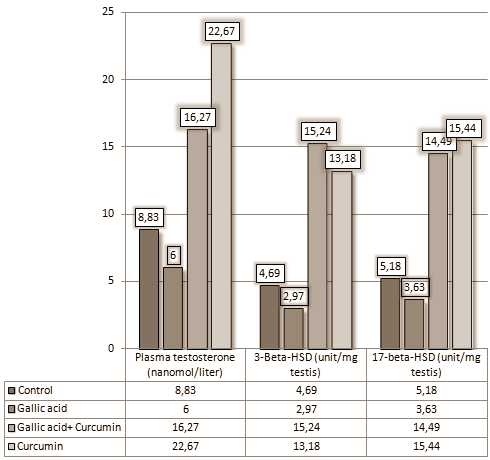In this study, we investigated the effects of administration of gallic acid (Gal) with or without curcumin (Cur) on the sperm output, steroid level and antioxidant defenses in rat testis in vivo and the expression of inflammatory responsive genes in vitro. Male Wistar rats were divided randomly into four groups and given oral Gal (100mg/kg/day) and Cur (100mg/kg/day) alone or in combination for four weeks. The sperm quality was impaired following Gal treatment, while Cur prevented this and also improved the sperm count as well as the efficiency of sperm production (DSP/gm testis). The inhibitory effects of Gal on plasma testosterone level, glutathione levels, activities of glutathione peroxidase, catalase, superoxide dismutase and steroidogenic enzymes, 3β-hydroxysteroid dehydrogenase (3β-HSD) and 17β-HSD in the rat testis was blocked by Cur. Interestingly, the level of testosterone and the activities of the steroidogenic enzymes were significantly increased after treatment with Cur alone. Malondialdehyde concentration was unchanged following Gal treatment, while a significant decrease in malondialdehyde level was observed following treatment with Cur alone or in combination with Gal. We further analyzed the effects of Cur and Gal (25-100μM) on the 93RS2 Sertoli cell-lines and observed that Cur blocked the Gal-induced suppression of inflammatory mediators such as TNF-α and IL-6, while Gal blocked the suppressive effect of Cur on IL-1α expression. Furthermore, the stimulatory or inhibitory effects of Gal on the expressions Tgf-β1 and CD-14 was concentration-dependent and could be blocked by Cur. When cultures of primary Sertoli cells were exposed to both Cur and Gal for 24h, p-JNK/SAPK expression remain stable, whereas Gal-induced p-p65 (NF-κB) expression and IκBα degradation was seen to be blocked by Cur but not Gal-induced expression of pERK1/2. Overall, Cur has stimulatory reproductive effects and could protect the testis from the toxic effects of Gal by mechanisms that could not be explained by its effects on the expressions of inflammatory cytokines but by its anti-oxidant properties.


